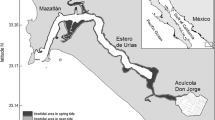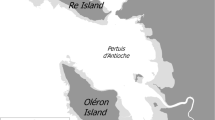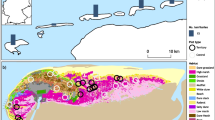Abstract
Man-made habitats provide suitable nesting, resting and feeding habitats for many birds at coastal sites. Despite intensive study outside Europe, very few data are available to date on the bird communities that exploit artificial intertidal sites along the European coasts. Between July 2009 and December 2010, 32 ornithological surveys were performed at six artificial intertidal sites in the lagoon of Venice (Italy). Overall, 101 species (with 23,399 birds) were observed, about a third of those occurring in the lagoon of Venice; 58 of these species were of conservation concern. Ten species comprised about 80 % of the total; bird abundance was the highest during the post-breeding migration and wintering period. Multivariate analysis identified similarity among sites, seasons and observed behaviours. Dredge islands were mostly used by waders as foraging sites, when surrounding tidal flats were still flooded. In winter the six dredged islands supported about 2 % of the dunlins Calidris alpina occurring in the whole lagoon of Venice and about 10 % of the grey plovers Pluvialis squatarola. Since the study sites comprised just the 6 % of the total dredge island area available in 2009–2010, the results indicate as large fractions of these shorebird populations might exploit the dredge island habitats for foraging. Among the newly created habitats, intertidal ponds and inner tidal flats were the most heavily used by birds, followed by dykes and mounds with ruderal vegetation. Maintenance of the habitat mosaic is a need for a conservation- based management of the dredge islands.









Similar content being viewed by others
References
ABP Southampton (1998) Review of costal habitat creation, restoration and recharge schemes. Report no. R.909. ABP Research & Consultancy Ltd., Southampton, UK
Atkinson PW (2003) Can we recreate or restore intertidal habitats for shorebirds? Wader Study Group Bull 100:67–72
Atkinson PW, Crooks S, Grant A, Rehlfish M (2001) The success of creation and restoration schemes in producing intertidal habitat suitable for waterbirds. English Nature Research Reports, no. 425. 166 pp
Bakker JP, Piersma T (2006) Restoration of intertidal flats and tidal salt marshes. In: van den Andel J, Aronson J (eds) Restoration Ecology. Blackwell Publishing, Singapore, pp. 174–192
Beauchard O, Sander J, Ysebaert T, Meire P (2013) Avian response to tidal fresh water habitat creation by controlled reduced tide system. Estuar Coast Shelf Sci 131:12–23
Bellio MG, Kingsford RT, Kotagama SW (2009) Natural versus artificial wetlands and their waterbirds in Sri Lanka. Biol Conserv 142:3076–3095
BirdLife International (2004) Birds in Europe: population estimates, trends and conservation status. Cambridge, UK. BirdLife Conservation Series no. 12
Boldreghini P, Dall’Alpi A (2008) Measuring the abundance and diversity of a waterbird community: numbers or biomass? Rev Catalana Ornitologia 24:79–87
Bon M, Scarton F (2012) Lo svernamento degli uccelli acquatici in provincia di Venezia (1993–2012). Provincia di Venezia – Assessorato alla caccia. 198 pp
Cecconi G (2005) Morphological restoration techniques. In: Fletcher CA, Spencer T (eds) Flooding and environmental challenges for Venice and its lagoon: state of knowledge. Cambridge University Press, Cambridge, pp. 461–472
Comune di Venezia (2014) Istituzione Centro Previsioni e Segnalazioni Maree. Internet: http://www.comune.venezia.it. Accessed 19 Oct 2014
Darnell TM, Smith EH (2004) Avian use of natural and created salt marsh in Texas, USA. Waterbirds 27:355–361
Davidson N, Evans PR (1986) The role and potential of man-made and man-modified wetlands in the enhancement of the survival of overwintering shorebirds. Colon Waterbirds 9:176–188
Day J, Ibáñez C, Scarton F, Pont D, Hensel P, Day J, Lane R (2011) Sustainability of Mediterranean deltaic wetlands with sea-level rise: the importance of river input. Estuar Coasts 34:483–493
De Jonge VN, de Jong DJ (2002) Ecological restoration in coastal areas in the Netherlands: concepts, dilemmas and some examples. Hydrobiologia 478:7–28
Delaney J, Webb W, Minello T (2000) Comparison of physical characteristics between created and natural estuarine marshes in Galveston Bay, Texas. Wetl Ecol Manag 8:343–352
Dias MP, Lecoq M, Moniz F, Rabaça JE (2014) Can human-made saltpans represent an alternative habitat for shorebirds? Implications for a predictable loss of estuarine sediment flats. Environ Manag 53:163–171
Emslie SD, Weske JS, Browne MM, Cameron S (2009) Population trends in Royal and Sandwich Terns along the mid-Atlantic seaboard, USA. Waterbirds 32:54–63
Erwin RM, Beck R (2007) Restoration of waterbird habitats in Chesapeake Bay: great expectations or Sisyphus revisited? Waterbirds 30(Special Publication 1):163–176
Erwin RM, Truitt BR, Jimenez JE (2001) Ground nesting waterbirds and mammalian carnivores in the Virginia Barrier island region: running out of options. J Coast Res 17:292–296
Erwin RM, Allen DH, Jenkins D (2003) Created versus natural coastal islands: Atlantic waterbird populations, habitat choices, and management implications. Estuaries 26:949–955
Evans PR, Ward RM, Bone M, Leakey M (1998) Creation of temperate-intertidal mud flats factors affecting colonization and use by benthic invertebrates and their bird predators. Mar Pollut Bull 37:535–545
Fasola M, Ruiz X (1996) The value of rice fields as substitutes for natural wetlands for waterbirds in the Mediterranean region. Colon Waterbirds 19:122–128
Ferrarin C, Ghezzo M, Umgiesser G, Tagliapietra D, Camatti E, Zaggia L, Sarretta A (2013) Assessing hydrological effects of human interventions on coastal systems: numerical applications to the Venice Lagoon. Hydrol Earth Syst Sci 17:1733–1748
Gallego Fernández B, García F (2007) High-intensity versus low-intensity restoration alternatives of a tidal marsh in Guadalquivir estuary, SW Spain. Ecol Eng 30:112–121
Golder W, Allen D, Cameron S, Wilder T (2008) Dredged material as a tool for management of tern and skimmer nesting habitats. DOER Technical Notes Collection (Erdc Tn-Doer-E24). U.S. Army Engineer Research And Development Center, Vicksburg, US
Gregory RD, Gibbons DW, Donald PF (2004) Bird census and survey techniques. In: Sutherland WJ, Newton I, Green RE (eds) Bird ecology and conservation; a handbook of techniques. Oxford University Press, Oxford, pp. 17–56
Guilfoyle MP, Fischer RA, Pashley DN, Lott CA (2007) Summary of First Regional Workshop on Dredging, Beach Nourishment, and Birds on the South Atlantic Coast Dredging Operations and Environmental Research Program ERDC/EL TR-06-10 September 2006
Hale WG, Scarton F, Valle R (2005) The taxonomic status of the Redshank Tringa totanus in Italy. Bull Br Ornithol Club 125:261–275
Hammer Ø, Harper DAT, Ryan PD (2001) PAST: paleontological statistics software package for education and data analysis. Palaeontol Electron 4:9. Web: http://folk.uio.no/ohammer/past
Jing K, Ma Z, Li B, Li J (2007) Foraging strategies involved in habitat use of shorebirds at the intertidal area of Chongminh Dongtan, China. Ecol Res 22:559–570
Lambshead PJD, Platt HM, Shaw KM (1983) The detection of differences among assemblages of marine benthic species based on an assessment of dominance and diversity. J Nat Hist 17:859–874
Liordos V (2010) Foraging guilds of waterbirds wintering in a Mediterranean coastal wetland. Zool Stud 49:311–323
Magurran A (2004) Measuring biological diversity. Blackwell Publishing, Malden
Malavasi R, Battisti C, Carpaneto GM (2009) Seasonal bird assemblages in a Mediterranean patchy wetland: Corroborating the intermediate disturbance hypothesis. Pol J Ecol 57:171–179
Mander L, Cutts ND, Allen J., Mazik K (2007) Assessing the development of newly created habitat for wintering estuarine birds. Estuar Coast Shelf Sci 75: 163–174.
Melvin SL, Webb JW (1998) Differences in the avian communities of natural and created Spartina alterniflora salt marshes. Wetlands 18:59–69
Múrias JA, Cabral Lopes R, Marques JC, Goss-Custard J (2002) Use of traditional salines by waders in the Mondego estuary (Portugal): a conservation perspective. Ardeola 49:223–240
Neckles HA, Dionne M, Burdick DM, Roman CT, Bucksbaum R, Hutchins E (2002) A monitoring protocol to assess tidal restoration of salt marshes on local and regional scales. Restor Ecol 10:556–563
Oro D, Martınez-Abrain A (2007) Deconstructing myths on large gulls and their impact on threatened sympatric waterbirds. Anim Conserv 10:117–126
Peronace V, Cecere JG, Gustin M, Rondinini C (2012) Lista Rossa 2011 degli uccelli nidificanti in Italia. Avocetta 36:11–58
Perry JE, Barnard TH, Bradshaw JC, Friedrichs CT, Havens KJ, Mason PA, Priest WI, Silberhorn GM (2001) Creating tidal salt marshes in the Chesapeake Bay. J Coast Res 27:170–191
Redolfi De Zan L, Battisti C, Carpaneto GM (2011) Inter-annual and intra-seasonal patterns of abundance in a set of common waterbirds: a long term study in a Mediterranean wetland. Vie Milieu 61:101–106
Santoul F, Figuerola J, Green AJ (2004) Importance of gravel pits for the conservation of waterbirds in the Garonne river floodplain (southwest France). Biodivers Conserv 13:12–31
Scarton F (2005) Breeding birds and vegetation monitoring in recreated salt marshes of the Venice lagoon. In: Fletcher CA, Spencer T (eds) Flooding and environmental challenges for Venice and its lagoon: state of knowledge. Cambridge University Press, Cambridge, pp. 573–579
Scarton F (2008) Population trend, colony size and distribution of little terns in the lagoon of Venice (Italy) between 1989 and 2003. Waterbirds 31:35–41
Scarton F (2010) Long term decline of a Common Tern (Sterna hirundo) population nesting in salt marshes in Venice lagoon, Italy. Wetlands 30:1153–1159
Scarton F, Bon M (2009) Gli uccelli acquatici svernanti in laguna di Venezia nel periodo 1993–2007: analisi delle dinamiche temporali e spaziali. Avocetta 33:87–99
Scarton F, Cecconi G, Cerasuolo C, Valle R (2013a) The importance of dredge islands for breeding waterbirds. A tree-year study in the Venice Lagoon (Italy). Ecol Eng 54:39–48
Scarton F, Cecconi G, Valle R (2013b) Use of dredge islands for a declining european shorebird, the Kentish Plover Charadrius alexandrinus. Wetl Ecol Manag 21:15–27
Sebastián-González E, Sánchez-Zapata JA, Botella F (2010) Agricultural ponds as alternative habitat for waterbirds: spatial and temporal patterns of abundance and management strategies. Eur J Wildl Res 56:11–20
Shafer DJ, Streever WJ (2000) A comparison of 28 natural and dredged material salt marshes in Texas with an emphasis on geomorphological variables. Wetl Ecol Manag 8:353–366
Soots RF, Landin MC (1978) Development and management of avian habitat on dredged material islands. US Army Engineer waterways Experiment Station Environmental Laboratory. TR DS-78-18
Soots RF, Parnell JF (1975) Ecological succession of breeding birds in relation to plant succession on dredge islands in North Carolina. UNC Sea Grant Publication UNC-SG-25-27. 91 pp
Spear K, Schweitzer S, Goodloe R, Harris D (2007) Effects of management strategies on the reproductive success of Least Terns on dredge spoil in Georgia. Southeast Nat 6:27–34
Spruzen FL, Richardson AMM, Woehler EJ (2008) Influence of environmental and prey variables on low tide shorebird use within the Robbins Passage wetlands, Northwest Tasmania. Estuar Coast Shelf Sci 78:122–134
Tourenq C, Bennets RE, Kowalski H, Vialet E, Licchesi JL, Kayser Y, Isenmann P (2001) Are rice fields a good alternative to natural marshes for waterbird communities in the Camargue, southern France? Biol Conserv 100:335–343
van de Kam EB, Piersma T, Zwarts L (2004) Shorebirds. An illustrated behavioural ecology. KNNV Publishers, Utrecht
Van Dusen B, Fegley SR, Peterson CH (2012) Prey distribution, physical habitat features, and guild traits interact to produce contrasting shorebird assemblages among foraging patches. PLoS One 7:1–14
Warnock N, Gary T, Page W, Ruhlen TD, Nur N, Takekawa JK, Hanson JT (2002) Management and conservation of San Francisco Bay salt ponds: effects of pond salinity, area, tide, and season on Pacific Flyway waterbirds. Waterbirds 25:79–92
Yozzo DJ, Wilber P, Will RJ (2004) Beneficial use of dredged material for habitat creation, enhancement, and restoration in New York–New Jersey Harbor. J Environ Manag 73:39–52
Ysebaert T, Meininger PL, Meire P, Devos K, Berrevoets CM, Strucker RCW, Kuijken E (2000) Waterbird communities along the estuarine salinity gradient of the Schelde estuary, NW-Europe. Biodivers Conserv 9:1275–1296
Zedler JB (ed) (2000) Handbook for restoring tidal wetlands. CRC Press, Boca Raton
Acknowledgments
Data were gathered within the framework of a study carried out for the Provveditorato Interregionale per le Opere Pubbliche per il Triveneto - Ministero dei Lavori Pubblici (Italian Ministry of Public Works) through its concessionary Consorzio Venezia Nuova. The assistance of C. Cerasuolo, F. Turco and P. Nascimbeni is warmly acknowledged. M. Baldin, P. Bertoldo and E. Checchin were of great help during field visits. An anonymous referee greatly improved the text.
Author information
Authors and Affiliations
Corresponding author
Rights and permissions
About this article
Cite this article
Scarton, F., Montanari, M. Use of artificial intertidal sites by birds in a Mediterranean lagoon and their importance for wintering and migrating waders. J Coast Conserv 19, 321–334 (2015). https://doi.org/10.1007/s11852-015-0394-8
Received:
Revised:
Accepted:
Published:
Issue Date:
DOI: https://doi.org/10.1007/s11852-015-0394-8




